Shockable rhythms - Study guides, Class notes & Summaries
Looking for the best study guides, study notes and summaries about Shockable rhythms? On this page you'll find 457 study documents about Shockable rhythms.
Page 4 out of 457 results
Sort by
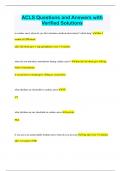
-
ACLS Questions and Answers with Verified Solutions
- Exam (elaborations) • 12 pages • 2024
-
- $10.89
- + learn more
ACLS Questions and Answers with Verified Solutions in cardiac arrest when do you first introduce medical intervention? which drug? after 2 rounds of CPR/shock after 2nd shock give 1 mg epinephrine every 3-5 minutes when do you introduce amiodarone during cardiac arrest? after the 3rd shock give 300 mg bolus of amiodarone if second dose is needed give 150mg as second dose what rhythms are shockable in cardiac arrest VF VT what rhythms are not shockable in cardiac arrest asystole PEA i...
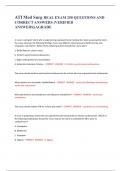
-
ATI Med Surg REAL EXAM 250 QUESTIONS AND CORRECT ANSWERS (VERIFIED ANSWERS)|AGRADE
- Exam (elaborations) • 41 pages • 2023
-
- $13.49
- + learn more
ATI Med Surg REAL EXAM 250 QUESTIONS AND CORRECT ANSWERS (VERIFIED ANSWERS)|AGRADE A nurse is caring for client who is experiencing supraventricular tachycardia. Upon assessing the client, the nurse observes the following findings: heart rate 200/min, blood pressure 78/40 mm Hg, and respiratory rate 30/min. Which of the following actions should then nurse take? a. Defibrillate the client's heart. b. Perform synchronized cardioversion. c. Begin cardiopulmonary resuscitation. d. Admin...
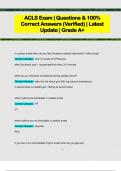
-
ACLS Exam | Questions & 100% Correct Answers (Verified) | Latest Update | Grade A+
- Exam (elaborations) • 12 pages • 2024
- Available in package deal
-
- $11.49
- + learn more
in cardiac arrest when do you first introduce medical intervention? which drug? Correct Answer: after 2 rounds of CPR/shock after 2nd shock give 1 mg epinephrine every 3-5 minutes when do you introduce amiodarone during cardiac arrest? Correct Answer: after the 3rd shock give 300 mg bolus of amiodarone if second dose is needed give 150mg as second dose what rhythms are shockable in cardiac arrest Correct Answer: VF VT what rhythms are not shockable in cardiac arrest Correct Answer: asy...

-
ACLS Heartcode exam 2023 with 100% correct answers
- Exam (elaborations) • 20 pages • 2023
-
Available in package deal
-
- $16.49
- + learn more
in cardiac arrest when do you first introduce medical intervention? which drug? correct answersafter 2 rounds of CPR/shock after 2nd shock give 1 mg epinephrine every 3-5 minutes when do you introduce amiodarone during cardiac arrest? correct answersafter the 3rd shock give 300 mg bolus of amiodarone if second dose is needed give 150mg as second dose what rhythms are shockable in cardiac arrest correct answersVF VT what rhythms are not shockable in cardiac arrest correct answersasyst...
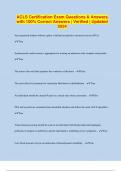
-
ACLS Certification Exam Questions & Answers with 100% Correct Answers | Verified | Updated 2024
- Exam (elaborations) • 22 pages • 2024
-
- $10.98
- + learn more
ACLS Certification Exam Questions & Answers with 100% Correct Answers | Verified | Updated 2024 Any organized rhythm without a pulse is defined as pulseless electrical activity (PEA). - True Synchronized cardioversion is appropriate for treating an unknown wide complex tachycardia. - True The aorta is the wall that separates the ventricles of the heart. - False The most effective treatment for ventricular fibrillation is defibrillation. - True An individual should be cleared-Ñ prior to...

-
AEMT NREMT Study Guide || with 100% Verified Solutions.
- Exam (elaborations) • 9 pages • 2024
-
Available in package deal
-
- $11.49
- + learn more
Compression/ Ventilation ratio for one rescuer? Two? correct answers 1 rescuer = 30:2 2 rescuers = 30:2 Pediatric 2 rescuer is 15:2 but otherwise stays the same What is the proper compression rate in CPR? correct answers 100-120 per minute Compression rate for: Adults Children? Infants: correct answers Adults: 2 inches Children: 1/3 depth of chest or 2 in Infants: 1.5 inches What are 2 rhythms are considered "shockable" rhythms? correct answers Ventricular Fibrilation Pulsele...
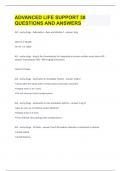
-
ADVANCED LIFE SUPPORT| 38 QUESTIONS AND ANSWERS
- Exam (elaborations) • 6 pages • 2023
- Available in package deal
-
- $14.49
- + learn more
ALS - early drugs - Adrenaline - dose and dilution? 1mg 10ml of 1:10,000 1ml of 1 in 1,000 ALS - early drugs - drug A for thrombolysis for suspected or proven cardiac arrest due to PE Tenecteplase 500 - 600 mcg/kg IV by bolus TeN CuT PLeaSe ALS - early drugs - adrenaline in shockable rhythm 1mg IV • Given after 3rd shock when compressions have been resumed • Repeat every 3 to 5 mins • Do not interrupt chest compressions ALS - early drugs - adrenaline in no...
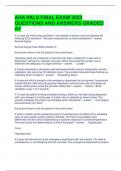
-
AHA PALS FINAL EXAM 2023 QUESTIONS AND ANSWERS GRADED A+
- Exam (elaborations) • 6 pages • 2023
-
Available in package deal
-
- $19.99
- 2x sold
- + learn more
AHA PALS FINAL EXAM 2023 QUESTIONS AND ANSWERS GRADED A+ A 12-year-old child being evaluated in the pediatric intensive care unit displays the following ECG waveform. The team interprets this as which arrhythmia? Second degree Second Degree Heart Block (Mobitz II) the picture shown is not the picture in the actual exam Laboratory tests are ordered for a child who has been vomiting for 3 days and is diaphoretic, tachypneic, lethargic and pale. Which test would the provider use ...

-
ACLS MUST KNOW Updated (2022/2023) Revisions
- Exam (elaborations) • 20 pages • 2024
- Available in package deal
-
- $11.48
- + learn more
What is the recommended compression depth for adults and children? 2 inches What is the recommended compression depth for infants? 1 1/2 inches What can result if a patient is ventilated too quickly? hyperventilation -> excessive intrathoracic pressure and gastric inflation -> decreased venous return -> decreased coronary and cerebral perfusion pressures -> diminished cardiac output -> decreased rates of survival What two cardiac arrest rhythms are shockable? VF and pVT ...
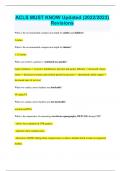
-
ACLS MUST KNOW Updated (2022/2023) Revisions
- Exam (elaborations) • 20 pages • 2024
- Available in package deal
-
- $11.49
- + learn more
What is the recommended compression depth for adults and children? 2 inches What is the recommended compression depth for infants? 1 1/2 inches What can result if a patient is ventilated too quickly? hyperventilation -> excessive intrathoracic pressure and gastric inflation -> decreased venous return -> decreased coronary and cerebral perfusion pressures -> diminished cardiac output -> decreased rates of survival What two cardiac arrest rhythms are shockable? VF and pVT ...

How did he do that? By selling his study resources on Stuvia. Try it yourself! Discover all about earning on Stuvia


